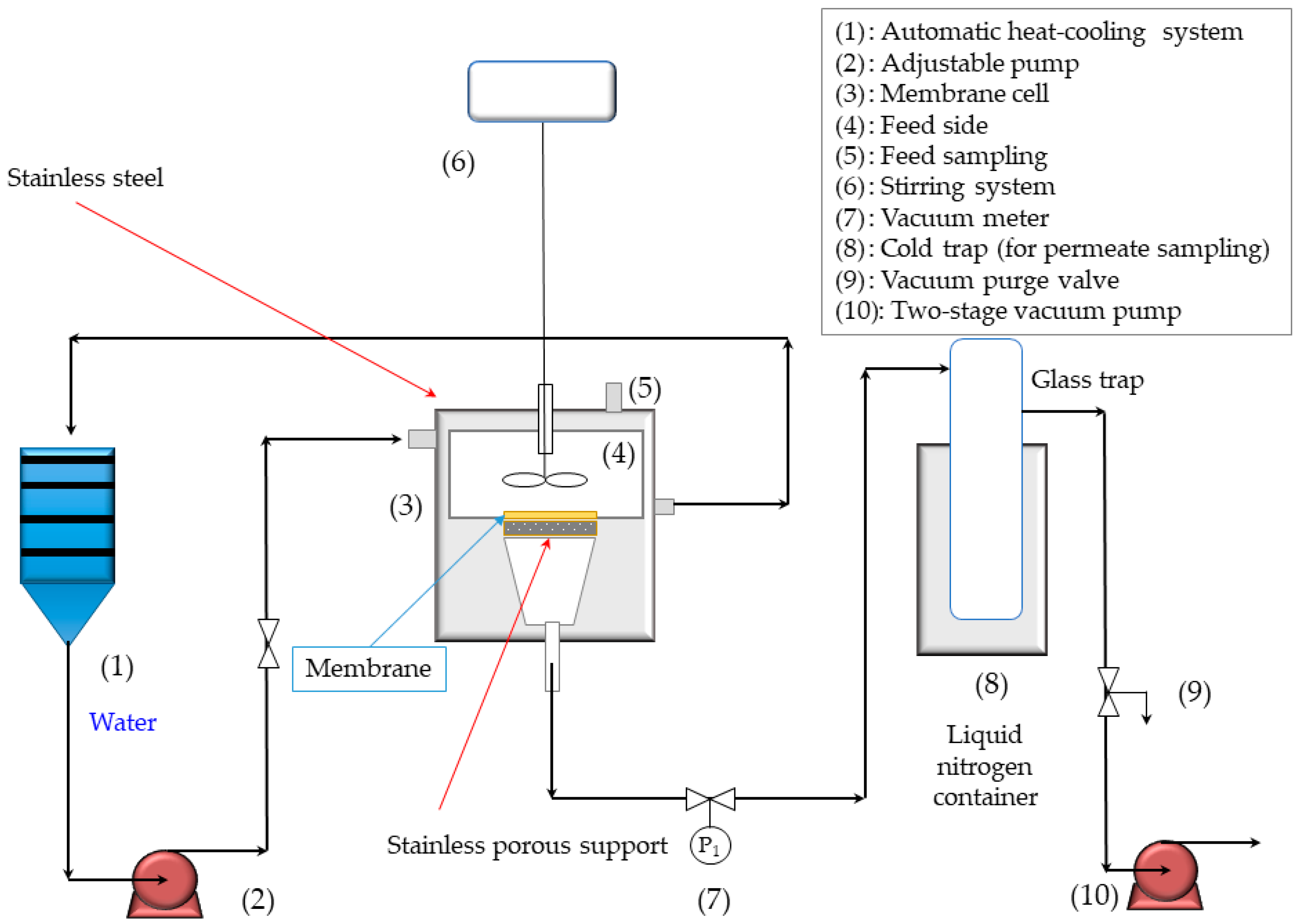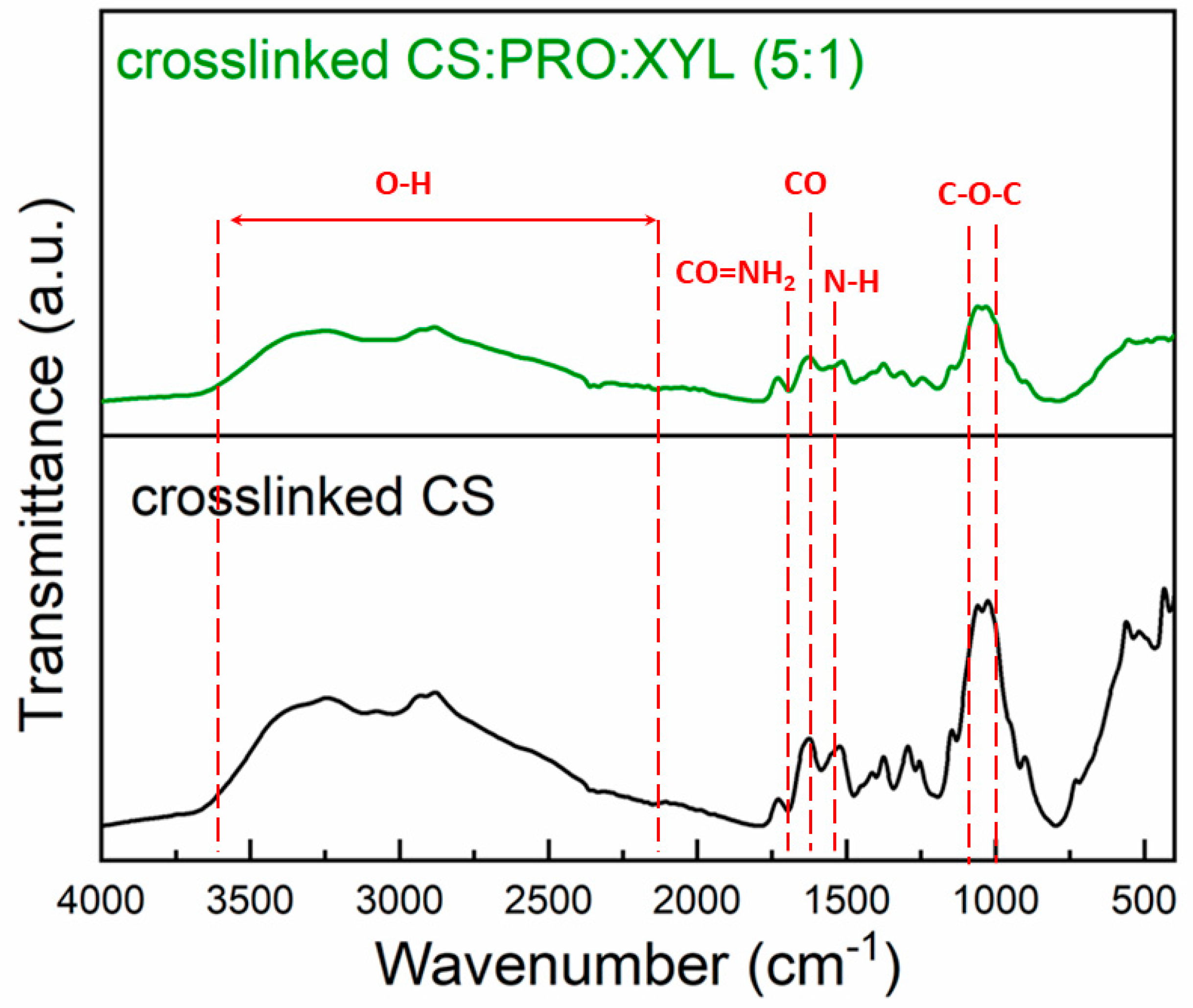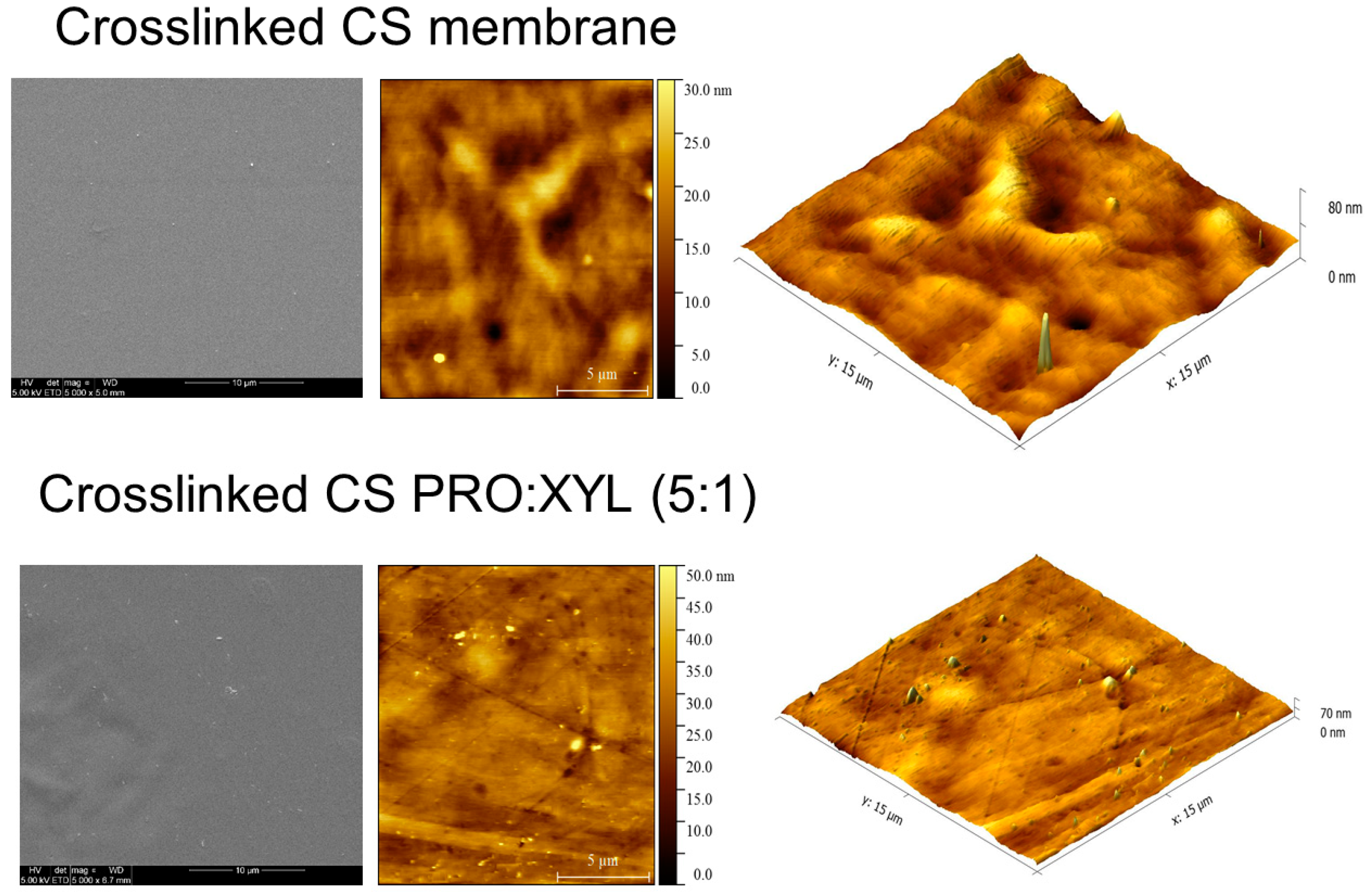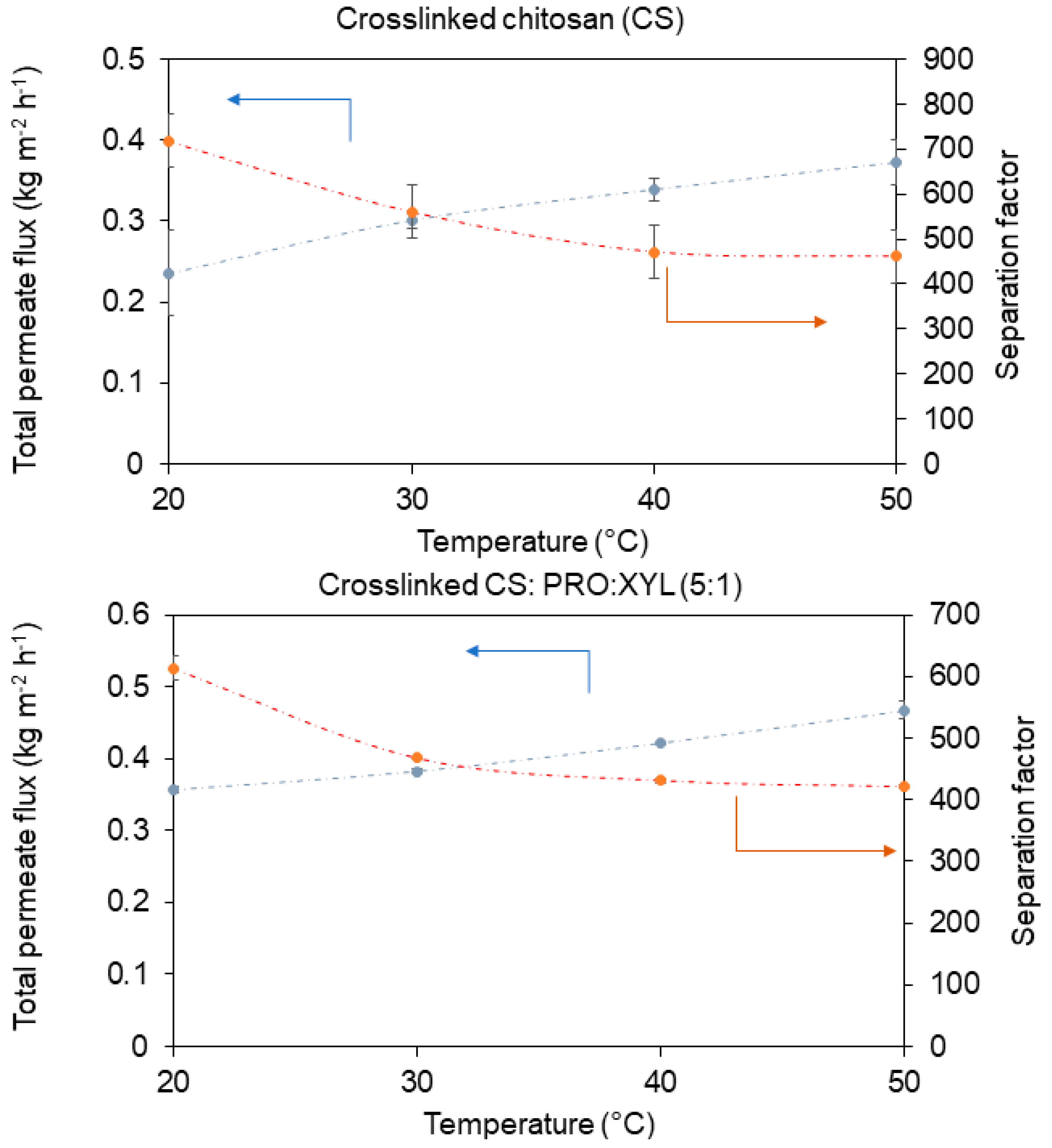Merging Proline:Xylitol Eutectic Solvent in Crosslinked Chitosan Pervaporation Membranes for Enhanced Water Permeation in Dehydrating Ethanol
Abstract
1. Introduction
2. Materials and Methods
2.1. Reactants and Materials
2.2. Hydrophilic DES Synthesis
2.3. Membrane Preparation
2.4. Characterization of Membrane Films
2.5. Pervaporation Separation Experiments for Binary Mixtures
2.6. Mass Transfer Evaluation in Prepared Membranes
3. Results and Discussion
3.1. Membrane Characterization
3.2. Pervaporation Performance towards Water-Ethanol Model Solutions
3.2.1. Effect of the Operating Temperature on Separation and Permeation
3.2.2. Mass-Transfer Resistance Analysis
3.2.3. Comparison of the Separation Performance of Crosslinked CS:PRO:XYL-Containing Membranes with the Literature
4. Conclusions
Supplementary Materials
Author Contributions
Funding
Institutional Review Board Statement
Data Availability Statement
Acknowledgments
Conflicts of Interest
References
- Galiano, F.; Briceño, K.; Marino, T.; Molino, A.; Christensen, K.V.; Figoli, A. Advances in Biopolymer-Based Membrane Preparation and Applications. J. Memb. Sci. 2018, 564, 562–586. [Google Scholar] [CrossRef]
- Cao, K.; Jiang, Z.; Zhang, X.; Zhang, Y.; Zhao, J.; Xing, R.; Yang, S.; Gao, C.; Pan, F. Highly Water-Selective Hybrid Membrane by Incorporating g-C3N4 Nanosheets into Polymer Matrix. J. Memb. Sci. 2015, 490, 72–83. [Google Scholar] [CrossRef]
- Meng, Z.X.; Wang, Y.S.; Ma, C.; Zheng, W.; Li, L.; Zheng, Y.F. Electrospinning of PLGA/Gelatin Randomly-Oriented and Aligned Nanofibers as Potential Scaffold in Tissue Engineering. Mater. Sci. Eng. C 2010, 30, 1204–1210. [Google Scholar] [CrossRef]
- Prihatiningtyas, I.; Gebreslase, G.A.; Van der Bruggen, B. Incorporation of Al2O3 into Cellulose Triacetate Membranes to Enhance the Performance of Pervaporation for Desalination of Hypersaline Solutions. Desalination 2020, 474, 114198. [Google Scholar] [CrossRef]
- Castro-Muñoz, R.; Gonzalez-Valdez, J.; Ahmad, Z. High-Performance Pervaporation Chitosan-Based Membranes: New Insights and Perspectives. Rev. Chem. Eng. 2020, 37, 959–974. [Google Scholar] [CrossRef]
- Wei, Y.C.; Hudson, S.M.; Mayer, J.M.; Kaplan, D.L. The Crosslinking of Chitosan Fibers. J. Polym. Sci. A Polym. Chem. 1992, 30, 2187–2193. [Google Scholar] [CrossRef]
- Cheng, P.I.; Da Hong, P.; Lee, K.R.; Lai, J.Y.; Tsai, Y.L. High Permselectivity of Networked PVA/GA/CS-Ag+-Membrane for Dehydration of Isopropanol. J. Memb. Sci. 2018, 564, 926–934. [Google Scholar] [CrossRef]
- Qian, X.; Li, N.; Wang, Q.; Ji, S. Chitosan/Graphene Oxide Mixed Matrix Membrane with Enhanced Water Permeability for High-Salinity Water Desalination by Pervaporation. Desalination 2018, 438, 83–96. [Google Scholar] [CrossRef]
- Gupta, O.; Roy, S.; Rao, L.; Mitra, S. Graphene Oxide-Carbon Nanotube (GO-CNT) Hybrid Mixed Matrix Membrane for Pervaporative Dehydration of Ethanol. Membranes 2022, 12, 1227. [Google Scholar] [CrossRef]
- Gupta, I.; Gupta, O. Recent Advancements in the Recovery and Reuse of Organic Solvents Using Novel Nanomaterial-Based Membranes for Renewable Energy Applications. Membranes 2023, 13, 108. [Google Scholar] [CrossRef]
- Castro-Muñoz, R.; Agrawal, K.V.; Lai, Z.; Coronas, J. Towards Large-Scale Application of Nanoporous Materials in Membranes for Separation of Energy-Relevant Gas Mixtures. Sep. Purif. Technol. 2023, 308, 122919. [Google Scholar] [CrossRef]
- Castro-Muñoz, R.; Galiano, F.; de la Iglesia, Ó.; Fíla, V.; Téllez, C.; Coronas, J.; Figoli, A. Graphene Oxide—Filled Polyimide Membranes in Pervaporative Separation of Azeotropic Methanol–MTBE Mixtures. Sep. Purif. Technol. 2019, 224, 265–272. [Google Scholar] [CrossRef]
- Jakubowska, E.; Gierszewska, M.; Nowaczyk, J.; Olewnik-Kruszkowska, E. Physicochemical and Storage Properties of Chitosan-Based Films Plasticized with Deep Eutectic Solvent. Food Hydrocoll. 2020, 108, 106007. [Google Scholar] [CrossRef]
- Castro-Muñoz, R.; Msahel, A.; Galiano, F.; Serocki, M.; Ryl, J.; Hamouda, S.B.; Hafiane, A.; Boczkaj, G.; Figoli, A. Towards Azeotropic MeOH-MTBE Separation Using Pervaporation Chitosan-Based Deep Eutectic Solvent Membranes. Sep. Purif. Technol. 2022, 281, 119979. [Google Scholar] [CrossRef]
- Khajavian, M.; Vatanpour, V.; Castro-Muñoz, R.; Boczkaj, G. Chitin and Derivative Chitosan-Based Structures—Preparation Strategies Aided by Deep Eutectic Solvents: A Review. Carbohydr. Polym. 2022, 275, 118702. [Google Scholar] [CrossRef]
- Ünlü, A.E.; Arlkaya, A.; Takaç, S. Use of Deep Eutectic Solvents as Catalyst: A Mini-Review. Green. Process. Synth. 2019, 8, 355–372. [Google Scholar] [CrossRef]
- Haq, H.U.; Balal, M.; Castro-Muñoz, R.; Hussain, Z.; Safi, F.; Ullah, S.; Boczkaj, G. Deep Eutectic Solvents Based Assay for Extraction and Determination of Zinc in Fish and Eel Samples Using FAAS. J. Mol. Liq. 2021, 333, 115930. [Google Scholar] [CrossRef]
- Serna-Vázquez, J.; Ahmad, M.Z.; Boczkaj, G.; Castro-Muñoz, R. Latest Insights on Novel Deep Eutectic Solvents (DES) for Sustainable Extraction of Phenolic Compounds from Natural Sources. Molecules 2021, 26, 5037. [Google Scholar] [CrossRef]
- Momotko, M.; Łuczak, J.; Przyjazny, A.; Boczkaj, G. A Natural Deep Eutectic Solvent—Protonated L-Proline-Xylitol—Based Stationary Phase for Gas Chromatography. J. Chromatogr. A 2022, 1676, 463238. [Google Scholar] [CrossRef]
- Dai, Z.; Aboukeila, H.; Ansaloni, L.; Deng, J.; Giacinti Baschetti, M.; Deng, L. Nafion/PEG Hybrid Membrane for CO2 Separation: Effect of PEG on Membrane Micro-Structure and Performance. Sep. Purif. Technol. 2019, 214, 67–77. [Google Scholar] [CrossRef]
- Dai, Z.; Ansaloni, L.; Ryan, J.J.; Spontak, R.J.; Deng, L. Nafion/IL Hybrid Membranes with Tuned Nanostructure for Enhanced CO2 Separation: Effects of Ionic Liquid and Water Vapor. Green. Chem. 2018, 20, 1391–1404. [Google Scholar] [CrossRef]
- Mahmoodi, N.M.; Taghizadeh, M.; Taghizadeh, A. Activated Carbon/Metal-Organic Framework Composite as a Bio-Based Novel Green Adsorbent: Preparation and Mathematical Pollutant Removal Modeling. J. Mol. Liq. 2019, 277, 310–322. [Google Scholar] [CrossRef]
- Casado-Coterillo, C.; Fernández-Barquín, A.; Zornoza, B.; Téllez, C.; Coronas, J.; Irabien, Á. Synthesis and Characterisation of MOF/Ionic Liquid/Chitosan Mixed Matrix Membranes for CO2/N2 Separation. RSC Adv. 2015, 5, 102350–102361. [Google Scholar] [CrossRef]
- Castro-Muñoz, R.; Gontarek-Castro, E.; Karczewski, J.; Cabezas, R.; Merlet, G.; Araya-Lopez, C.; Boczkaj, G. Hybrid Cross-Linked Chitosan/Protonated-Proline:Glucose DES Membranes with Superior Pervaporation Performance for Ethanol Dehydration. J. Mol. Liq. 2022, 360, 119499. [Google Scholar] [CrossRef]
- Arregoitia-Sarabia, C.; González-Revuelta, D.; Fallanza, M.; Gorri, D.; Ortiz, I. Polymer Inclusion Membranes Containing Ionic Liquids for the Recovery of N-Butanol from ABE Solutions by Pervaporation. Sep. Purif. Technol. 2020, 248, 117101. [Google Scholar] [CrossRef]
- Garcia, V.; Diban, N.; Gorri, D.; Keiski, R.; Urtiaga, A.; Ortiz, I. Separation and Concentration of Bilberry Impact Aroma Compound from Dilute Model Solution by Pervaporation. J. Chem. Technol. Biotechnol. 2008, 83, 973–982. [Google Scholar] [CrossRef]
- Castro-Muñoz, R.; Cichocki, Ł.; Plata-Gryl, M.; Boczkaj, G.; Galiano, F. Performance Tuning of Chitosan-Based Membranes by Protonated 2-Pyrrolidone-5-Carboxylic Acid-Sulfolane DES for Effective Water/Ethanol Separation by Pervaporation. Chem. Eng. Res. Des. 2023, 191, 401–413. [Google Scholar] [CrossRef]
- Kong, M.; Chen, X.G.; Xing, K.; Park, H.J. Antimicrobial Properties of Chitosan and Mode of Action: A State of the Art Review. Int. J. Food Microbiol. 2010, 144, 51–63. [Google Scholar] [CrossRef]
- Mathaba, M.; Daramola, M.O. Effect of Chitosan’s Degree of Deacetylation on the Performance of Pes Membrane Infused with Chitosan during Amd Treatment. Membranes 2020, 10, 52. [Google Scholar] [CrossRef]
- Pandey, A.; Rai, R.; Pal, M.; Pandey, S. How Polar Are Choline Chloride-Based Deep Eutectic Solvents? Phys. Chem. Chem. Phys. 2014, 16, 1559–1568. [Google Scholar] [CrossRef]
- Huang, R.Y.M.; Yeom, C.K. Pervaporation Separation of Aqueous Mixtures Using Crosslinked Poly(Vinyl Alcohol)(Pva). II. Permeation of Ethanol-Water Mixtures. J. Memb. Sci. 1990, 51, 273–292. [Google Scholar] [CrossRef]
- Alshammari, O.A.O.; Almulgabsagher, G.A.A.; Ryder, K.S.; Abbott, A.P. Effect of Solute Polarity on Extraction Efficiency Using Deep Eutectic Solvents. Green. Chem. 2021, 23, 5097–5105. [Google Scholar] [CrossRef]
- Jiang, B.; Zhang, N.; Wang, B.; Yang, N.; Huang, Z.; Yang, H.; Shu, Z. Deep Eutectic Solvent as Novel Additive for PES Membrane with Improved Performance. Sep. Purif. Technol. 2018, 194, 239–248. [Google Scholar] [CrossRef]
- Jiang, B.; Zhang, N.; Zhang, L.; Sun, Y.; Huang, Z.; Wang, B.; Dou, H.; Guan, H. Enhanced Separation Performance of PES Ultrafiltration Membranes by Imidazole-Based Deep Eutectic Solvents as Novel Functional Additives. J. Memb. Sci. 2018, 564, 247–258. [Google Scholar] [CrossRef]
- Hadj-Kali, M.K.; Hizaddin, H.F.; Wazeer, I.; El Blidi, L.; Mulyono, S.; Hashim, M.A. Liquid-Liquid Separation of Azeotropic Mixtures of Ethanol/Alkanes Using Deep Eutectic Solvents: COSMO-RS Prediction and Experimental Validation. Fluid. Phase Equilib. 2017, 448, 105–115. [Google Scholar] [CrossRef]
- Pontillo, A.R.N.; Koutsoukos, S.; Welton, T.; Detsi, A. Investigation of the Influence of Natural Deep Eutectic Solvents (NaDES) in the Properties of Chitosan-Stabilised Films. Mater. Adv. 2021, 2, 3954–3964. [Google Scholar] [CrossRef]
- Cichoki, L.; Warmiska, D.; Luczak, J.; Przyjazny, A.; Boczkaj, G. New Simple and Robust Method for Determination of Polarity of Deep Eutectic Solvents (DESs) by Means of Contact. Molecules 2022, 27, 4198. [Google Scholar] [CrossRef]
- Dharupaneedi, S.P.; Anjanapura, R.V.; Han, J.M.; Aminabhavi, T.M. Functionalized Graphene Sheets Embedded in Chitosan Nanocomposite Membranes for Ethanol and Isopropanol Dehydration via Pervaporation. Ind. Eng. Chem. Res. 2014, 53, 14474–14484. [Google Scholar] [CrossRef]
- Tsai, H.S.; Wang, Y.Z. Properties of Hydrophilic Chitosan Network Membranes by Introducing Binary Crosslink Agents. Polym. Bull. 2008, 60, 103–113. [Google Scholar] [CrossRef]
- Nagel, C.; Günther-Schade, K.; Fritsch, D.; Strunskus, T.; Faupel, F. Free Volume and Transport Properties in Highly Selective Polymer Membranes. Macromolecules 2002, 35, 2071–2077. [Google Scholar] [CrossRef]
- Krishna, R. Highlighting Thermodynamic Coupling Effects in Alcohol/Water Pervaporation across Polymeric Membranes. ACS Omega 2019, 4, 15255–15264. [Google Scholar] [CrossRef] [PubMed]
- Farhan, N.M.; Ibrahim, S.S.; Alsalhy, Q.F. Modeling and Simulation of Pervaporation (PV) Separation for Alcohol Dehydration. Heliyon 2023, 9, e13713. [Google Scholar] [CrossRef] [PubMed]
- Jiraratananon, R.; Chanachai, A.; Huang, R.Y.M. Pervaporation Dehydration of Ethanol–Water Mixtures with Chitosan/Hydroxyethylcellulose (CS/HEC) Composite Membranes: II. Analysis of Mass Transport. J. Memb. Sci. 2002, 199, 211–222. [Google Scholar] [CrossRef]
- Xue, Y.L.; Huang, J.; Lau, C.H.; Cao, B.; Li, P. Tailoring the Molecular Structure of Crosslinked Polymers for Pervaporation Desalination. Nat. Commun. 2020, 11, 1461. [Google Scholar] [CrossRef] [PubMed]
- Huang, R.Y.M.; Yeom, C.K. Pervaporation Separation of Aqueous Mixtures Using Crosslinked Polyvinyl Alcohol Membranes. III. Permeation of Acetic Acid-Water Mixtures. J. Memb. Sci. 1991, 58, 33–47. [Google Scholar] [CrossRef]
- Rostovtseva, V.; Pulyalina, A.; Dubovenko, R.; Faykov, I.; Subbotina, K.; Saprykina, N.; Novikov, A.; Vinogradova, L.; Polotskaya, G. Enhancing Pervaporation Membrane Selectivity by Incorporating Star Macromolecules Modified with Ionic Liquid for Intensification of Lactic Acid Dehydration. Polymers 2021, 13, 1811. [Google Scholar] [CrossRef]
- Baker, R.W.; Wijmans, J.G.; Huang, Y. Permeability, Permeance and Selectivity: A Preferred Way of Reporting Pervaporation Performance Data. J. Memb. Sci. 2010, 348, 346–352. [Google Scholar] [CrossRef]
- Rezakazemi, M.; Ebadi Amooghin, A.; Montazer-Rahmati, M.M.; Ismail, A.F.; Matsuura, T. State-of-the-Art Membrane Based CO2 Separation Using Mixed Matrix Membranes (MMMs): An Overview on Current Status and Future Directions. Prog. Polym. Sci. 2014, 39, 817–861. [Google Scholar] [CrossRef]
- Castro-Muñoz, R.; Buera-Gonzalez, J.; de la Iglesia, O.; Galiano, F.; Fíla, V.; Malankowska, M.; Rubio, C.; Figoli, A.; Tellez, C.; Coronas, J. Towards the Dehydration of Ethanol Using Pervaporation Cross-Linked Poly(Vinyl Alcohol)/Graphene Oxide Membranes. J. Memb. Sci. 2019, 582, 423–434. [Google Scholar] [CrossRef]
- Sun, H.; Lu, L.; Chen, X.; Jiang, Z. Pervaporation Dehydration of Aqueous Ethanol Solution Using H-ZSM-5 Filled Chitosan Membranes. Sep. Purif. Technol. 2008, 58, 429–436. [Google Scholar] [CrossRef]
- Adoor, S.G.; Manjeshwar, L.S.; Bhat, S.D.; Aminabhavi, T.M. Aluminum-Rich Zeolite Beta Incorporated Sodium Alginate Mixed Matrix Membranes for Pervaporation Dehydration and Esterification of Ethanol and Acetic Acid. J. Memb. Sci. 2008, 318, 233–246. [Google Scholar] [CrossRef]
- Kudasheva, A.; Sorribas, S.; Zornoza, B.; Téllez, C.; Coronas, J. Pervaporation of Water/Ethanol Mixtures through Polyimide Based Mixed Matrix Membranes Containing ZIF-8, Ordered Mesoporous Silica and ZIF-8-Silica Core-Shell Spheres. J. Chem. Technol. Biotechnol. 2015, 90, 669–677. [Google Scholar] [CrossRef]
- Yang, D.; Li, J.; Jiang, Z.; Lu, L.; Chen, X. Chitosan/TiO2 Nanocomposite Pervaporation Membranes for Ethanol Dehydration. Chem. Eng. Sci. 2009, 64, 3130–3137. [Google Scholar] [CrossRef]
- Liu, Y.L.; Hsu, C.Y.; Su, Y.H.; Lai, J.Y. Chitosan-Silica Complex Membranes from Sulfonic Acid Functionalized Silica Nanoparticles for Pervaporation Dehydration of Ethanol-Water Solutions. Biomacromolecules 2005, 6, 368–373. [Google Scholar] [CrossRef]
- Zhang, H.; Wang, Y. Poly(Vinyl Alcohol)/ZIF-8-NH2 Mixed Matrix Membranes for Ethanol Dehydration via Pervaporation. AIChE J. 2016, 62, 1728–1739. [Google Scholar] [CrossRef]
- Guo, J.C.; Zou, C.; Chiang, C.Y.; Chang, T.A.; Chen, J.J.; Lin, L.C.; Kang, D.Y. NaP1 Zeolite Membranes with High Selectivity for Water-Alcohol Pervaporation. J. Memb. Sci. 2021, 639, 119762. [Google Scholar] [CrossRef]
- Schehlmann, M.S.; Wiedemann, E.; Lichtenthaler, R.N. Pervaporation and Vapor Permeation at the Azeotropic Point or in the Vicinity of the LLE Boundary Phases of Organic/Aqueous Mixtures. J. Memb. Sci. 1995, 107, 277–282. [Google Scholar] [CrossRef]
- Van Baelen, D.; Van Der Bruggen, B.; Van Den Dungen, K.; Degreve, J.; Vandecasteele, C. Pervaporation of Water-Alcohol Mixtures and Acetic Acid-Water Mixtures. Chem. Eng. Sci. 2005, 60, 1583–1590. [Google Scholar] [CrossRef]









| Membrane | Activation Energy Values (kJ/mol) | ||
|---|---|---|---|
| Total | Water | Ethanol | |
| Crosslinked CS | 5.15 | 5.07 | 10.27 |
| Crosslinked CS:PRO:XYL | 3.10 | 3.02 | 7.21 |
| T (°C) | Crosslinked CS | Crosslinked CS:PRO:XYL (5:1) | ||
|---|---|---|---|---|
| αW/E | PSI (kg m−2 h−1) | αW/E | PSI (kg m−2 h−1) | |
| 20 | 718.6 ± 15.3 | 166.8 ± 17 | 613.5 ± 19.0 | 218.2 ± 0 |
| 30 | 561.1 ± 23.8 | 168.5 ± 1 | 467.4 ± 0.7 | 178.3 ± 2 |
| 40 | 471.6 ± 4.4 | 159.5 ± 2 | 430.9 ± 4.4 | 181.2 ± 1 |
| 50 | 461.9 ± 2.2 | 171.7± 5 | 421.2 ± 1.9 | 196.2 ± 3 |
| Membrane | WCA (°) | Eapp (kJ mol−1) | J (kg m−2 h−1) | REthanol/Water | SW/E | PSI (kg m−2 h−1) | Reference |
|---|---|---|---|---|---|---|---|
| CS:PRO:XYL | 79 | 3.10 | 0.3823 | 246 | 246 | 218 | This work |
| CS:PRO:GLU | 50 | 5.63 | 0.3022 | 614 | 600 | 181 | [24] |
| CS:PCA:SULF | 100 | 5.54 | 0.3469 | 259 | 494 | 171 | [27] |
| Membrane Material | Filler Loading | Water Concentration | Operating Conditions | J (kg m−2 h−1) | Separation Factor (α) | Reference |
|---|---|---|---|---|---|---|
| Crosslinked CS:PRO:XYL | - | 10 wt.% | 20 °C, 1 mbar | 0.356 | 613 | This work |
| Crosslinked CS:PRO:XYL | 10 wt.% | 50 °C, 1 mbar | 0.467 | 421 | This work | |
| Crosslinked PVA-filled GO | 1 wt.% | 10 wt.% | 40 °C, 3 mbar | 0.137 | 263 | [49] |
| CS-filled H-ZSM-5 | 8 wt.% | 10 wt.% | 80 °C, 10 mbar | 0.230 | 152 | [50] |
| Crosslinked sodium alginate-filled beta zeolite | 10 wt.% | 10 wt.% | 30 °C, 0.6 mbar | 0.130 | 1600 | [51] |
| Polyimide-filled ZIF-8 | 12 wt.% | 10 wt.% | 42 °C, 44 mbar | 0.260 | 300 | [52] |
| CS-filled TiO2 | 6 wt.% | 10 wt.% | 80 °C, 50 mbar | 0.340 | 196 | [53] |
| Polyimide-filled MSS-1 | 12 wt.% | 10 wt.% | 42 °C, 44 mbar | 0.310 | 190 | [52] |
| Crosslinked CS-filled silica | 5 wt.% | 10 wt.% | 70 °C, 10 mbar | 0.410 | 919 | [54] |
| Crosslinked PVA-filled ZIF-8-NH2 | 7.5 wt.% | 15 wt.% | 40 °C, 1 mbar | 0.120 | 200 | [55] |
| NaP1 zeolite membranes | - | 10 wt.% | 75 °C, 4 mbar | 0.45 | 200,000 | [56] |
| PVA composite membrane (Deutsche Carbone AG/GFT) | - | 10 wt.% | 60 °C, 5 mbar | 0.140 | 170 | [57] |
| PVA composite membrane (PERVAP 2201, Sulzer Chemtech) | - | 10 wt.% | 60 °C, 10 mbar | 0.100 | 100 | [58] |
| Crosslinked CS:PRO:GLU | - | 10 wt.% | 20 °C, 1 mbar | 0.242 | 1425 | [24] |
| Crosslinked CS:PRO:GLU | 10 wt.% | 50 °C, 1 mbar | 0.389 | 831.7 | [24] |
Disclaimer/Publisher’s Note: The statements, opinions and data contained in all publications are solely those of the individual author(s) and contributor(s) and not of MDPI and/or the editor(s). MDPI and/or the editor(s) disclaim responsibility for any injury to people or property resulting from any ideas, methods, instructions or products referred to in the content. |
© 2023 by the authors. Licensee MDPI, Basel, Switzerland. This article is an open access article distributed under the terms and conditions of the Creative Commons Attribution (CC BY) license (https://creativecommons.org/licenses/by/4.0/).
Share and Cite
Castro-Muñoz, R.; Plata-Gryl, M.; Boczkaj, G. Merging Proline:Xylitol Eutectic Solvent in Crosslinked Chitosan Pervaporation Membranes for Enhanced Water Permeation in Dehydrating Ethanol. Membranes 2023, 13, 451. https://doi.org/10.3390/membranes13040451
Castro-Muñoz R, Plata-Gryl M, Boczkaj G. Merging Proline:Xylitol Eutectic Solvent in Crosslinked Chitosan Pervaporation Membranes for Enhanced Water Permeation in Dehydrating Ethanol. Membranes. 2023; 13(4):451. https://doi.org/10.3390/membranes13040451
Chicago/Turabian StyleCastro-Muñoz, Roberto, Maksymilian Plata-Gryl, and Grzegorz Boczkaj. 2023. "Merging Proline:Xylitol Eutectic Solvent in Crosslinked Chitosan Pervaporation Membranes for Enhanced Water Permeation in Dehydrating Ethanol" Membranes 13, no. 4: 451. https://doi.org/10.3390/membranes13040451
APA StyleCastro-Muñoz, R., Plata-Gryl, M., & Boczkaj, G. (2023). Merging Proline:Xylitol Eutectic Solvent in Crosslinked Chitosan Pervaporation Membranes for Enhanced Water Permeation in Dehydrating Ethanol. Membranes, 13(4), 451. https://doi.org/10.3390/membranes13040451








